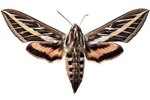
Backswimmers (genus Notonecta) certainly deserve their name. These bugs swim belly-up along the surface of ponds, streams and other bodies of freshwater. Their bodies stay mostly below the surface as they row, and they are able to submerge themselves completely for short periods of time.
Adult
Adults backswimmers are equipped with paddlelike limbs that propels them through the water. While they can swim right side up, they are usually found paddling around on their back. The bugs can trap small pockets of air against their bodies, which allows them to submerge themselves completely to chase underwater prey. They are carnivorous insects who prey on small fish as well as various insects, including others of their own kind. They are relatively small, at an average adult length of less than a half-inch. Their poisonous bite is painful for humans and larger animals but is not particularly dangerous.
Egg
Adult male backswimmers attract females by vibrating their bodies to create a distinct sound much like crickets do. Females take fertilized eggs beneath the water's surface to deposit them in safe locationsw along the bottom. Eggs may be buried in the mud or attached to source of shelters like plant leaves and debris. Adults can deposit eggs in depths of up to 30 feet, although they can lay them in shallow water as well. The eggs usually hatch one to two weeks after they were deposited.
Larva
Larvae go through lengthy and intermittent metamorphoses before reaching adulthood. Backswimmer larvae look almost exactly like adults when they hatch from the eggs, although they lack functional wings that allow the mature bugs to take flight. The larvae develop through five stages called instars. They molt at the end of each of these stages and emerge as adults at the end of their final metamorphosis. Each instar can last a week or more, so backswimmers spend several months in the larval stage.
Ecology
Scientists aren't alone in their interest in understanding the backswimmer's life cycle. Keen fishermen study the stages to understand how to develop bait to catch fish that prey on these insects. Backswimmers produce only one generation per year, so their development tends to be routine and seasonal. While there is some predictability, it's possible for the dates of the generational cycle to change from one year to the next.
References
Photo Credits
-
Jupiterimages/Photos.com/Getty Images
Writer Bio
Quentin Coleman has written for various publications, including All Pet News and Safe to Work Australia. He spent more tan 10 years nursing kittens, treating sick animals and domesticating semi-feral cats for a local animal shelter. He graduated from the University of Delaware with a bachelor's degree in journalism.




